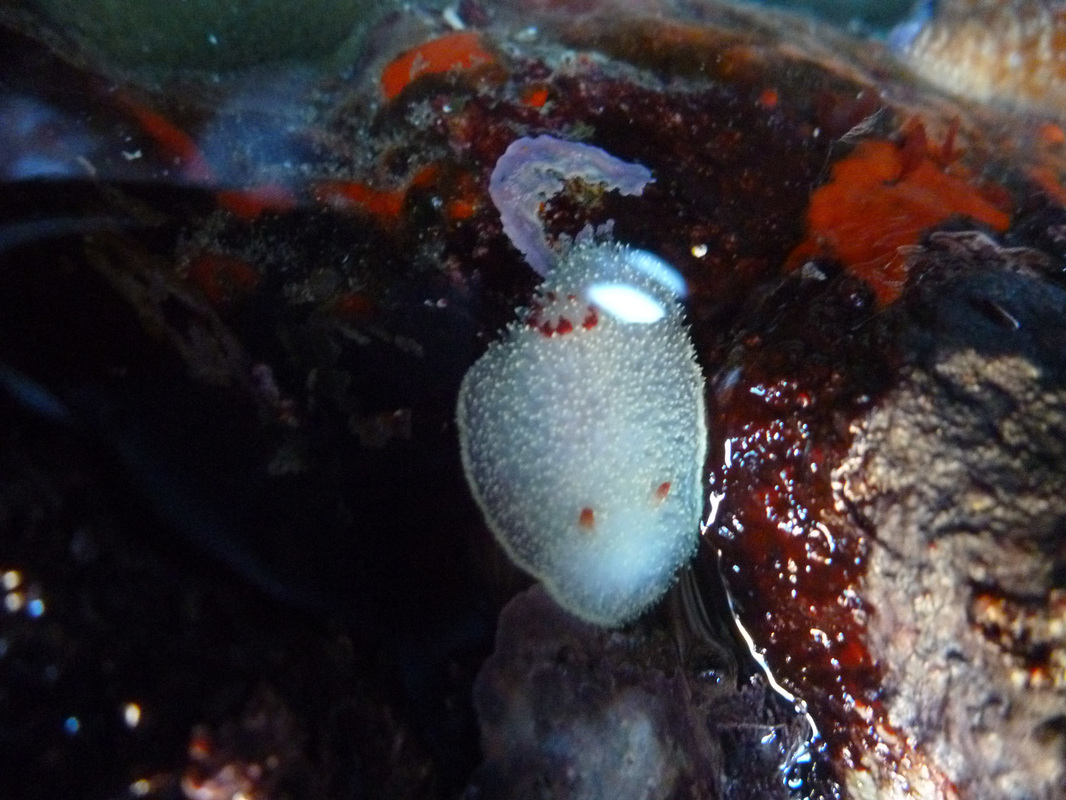Nanaimo dorid, red-gilled dorid, wine-plumed spiny dorid • Acanthodoris nanaimoensis

A nanaimo dorid photographed by Angeleen Olson.
Identification
The Nanaimo dorid can be easily distinguished by its dark red-tipped rhinophores and gill plume. The amount of red varies, but regardless it contrasts strongly against the nudibranch's white or greyish-white body — though occasionally individuals, particularly larger ones, may be darker brownish or greyish. This nudibranch's long papillae, which give it a furry appearance, are tipped with light yellow, and its oval-shaped body is lined with a light yellow margin. This species reaches 4 cm long, though it is usually smaller. This species' white or cream-coloured egg ribbon, laid in whorls, have a foamy appearance.
Habitat & Range
The Nanaimo dorid inhabits rocky areas in the intertidal and shallow subtidal, recorded to 25 m deep. Its range extends from central Alaska to Santa Barbara, California.
Similar Species
There are quite a few similar white or whitish dorid nudibranchs, but none have the distinctive red-tipped gills and rhinophores. The closest lookalike is Hudson's dorid (Acanthodoris hudsoni), which has the same long, yellow-tipped papillae and yellow foot margin but lacks the red colouring.
Intriguing Info
One source reports that this species can give off a scent like cedar or sandalwood when handled. It feeds on bryozoans, such as Alcyonidium spp., as well as compound ascidians.
iNaturalist
https://www.inaturalist.org/taxa/47476-Acanthodoris-nanaimoensis
The Nanaimo dorid can be easily distinguished by its dark red-tipped rhinophores and gill plume. The amount of red varies, but regardless it contrasts strongly against the nudibranch's white or greyish-white body — though occasionally individuals, particularly larger ones, may be darker brownish or greyish. This nudibranch's long papillae, which give it a furry appearance, are tipped with light yellow, and its oval-shaped body is lined with a light yellow margin. This species reaches 4 cm long, though it is usually smaller. This species' white or cream-coloured egg ribbon, laid in whorls, have a foamy appearance.
Habitat & Range
The Nanaimo dorid inhabits rocky areas in the intertidal and shallow subtidal, recorded to 25 m deep. Its range extends from central Alaska to Santa Barbara, California.
Similar Species
There are quite a few similar white or whitish dorid nudibranchs, but none have the distinctive red-tipped gills and rhinophores. The closest lookalike is Hudson's dorid (Acanthodoris hudsoni), which has the same long, yellow-tipped papillae and yellow foot margin but lacks the red colouring.
Intriguing Info
One source reports that this species can give off a scent like cedar or sandalwood when handled. It feeds on bryozoans, such as Alcyonidium spp., as well as compound ascidians.
iNaturalist
https://www.inaturalist.org/taxa/47476-Acanthodoris-nanaimoensis
References
Cowles, D. (2007). Acanthodoris nanaimoensis O'Donoghue, 1921. Invertebrates of the Salish Sea. Rosario Beach Marine Laboratory. Accessed 01/04/2016.
Harbo, R. M. (1999). Whelks to whales: Coastal marine life of the Pacific Northwest. Madeira Park, BC: Harbour Publishing. P. 114.
Lamb, A., and Hanby, B. (2005). Marine Life of the Pacific Northwest [electronic version]. Madeira Park, BC: Harbour Publishing.
McDonald, G. Acanthodoris nanaimoensis O'Donoghue, 1921. Intertidal Invertebrates of the Monterey Bay Area, California. Long Marine Laboratory, University of California, Santa Cruz. Accessed 01/04/2016.
Authors and editors
Kelly Fretwell (2016).
Cowles, D. (2007). Acanthodoris nanaimoensis O'Donoghue, 1921. Invertebrates of the Salish Sea. Rosario Beach Marine Laboratory. Accessed 01/04/2016.
Harbo, R. M. (1999). Whelks to whales: Coastal marine life of the Pacific Northwest. Madeira Park, BC: Harbour Publishing. P. 114.
Lamb, A., and Hanby, B. (2005). Marine Life of the Pacific Northwest [electronic version]. Madeira Park, BC: Harbour Publishing.
McDonald, G. Acanthodoris nanaimoensis O'Donoghue, 1921. Intertidal Invertebrates of the Monterey Bay Area, California. Long Marine Laboratory, University of California, Santa Cruz. Accessed 01/04/2016.
Authors and editors
Kelly Fretwell (2016).




